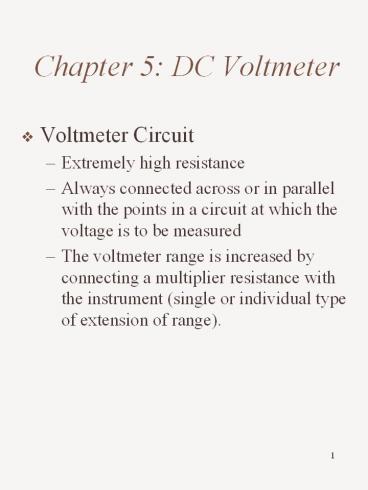Voltmeter Circuit PowerPoint PPT Presentation
1 / 16
Title: Voltmeter Circuit
1
Chapter 5 DC Voltmeter
- Voltmeter Circuit
- Extremely high resistance
- Always connected across or in parallel with the
points in a circuit at which the voltage is to be
measured - The voltmeter range is increased by connecting a
multiplier resistance with the instrument (single
or individual type of extension of range).
2
(No Transcript)
3
- Example 5.1 A PMMC instrument with FSD of 100
?A and a coil resistance of 1k? is to be
converted into a voltmeter. Determine the
required multiplier resistance if the voltmeter
is to measure 50V at full scale (Figure 3-15).
Also calculate the applied voltage when the
instrument indicate 0.8, 0.5, and 0.2 of FSD. - Solution
- For V50V FSD
4
- At 0.8 FSD
- At 0.5 FSD
- At 0.2 FSD
- The voltmeter designed in Example 5.1 has a total
resistance of Rv RsRm 500k? . Since the
instrument measures 50V at full scale, its
resistance per volt or sensitivity is 500k? / 50V
10 k? / V. - The sensitivity of a voltmeter is always
specified by the manufacturer, and it is
frequently printed on the scale of the instrument.
5
- Swamping Resistance
- The change in coil resistance (Rm) with
temperature change can introduce errors in a PMMC
voltmeter.
6
- The presence of the voltmeter multiplier
resistance (Rs) tends to swamp coil resistance
changes, except for low voltage ranges where Rx
is not very much larger than Rm. - Multi-range Voltmeter
- In Figure 3.16(a), only one of the three
multiplier resistors is connected in series with
the meter at any time. - The range of this voltmeter is
- V Im(RmR)
- where R can be R1, R2, or R3
7
- In Figure 3.16(b), the multiplier resistors are
connected in series, and each junction is
connected to one of the switch terminals. - The range of this voltmeter can also be
calculated from the equation - V Im(RmR)
- where R can now be R1, R1R2, or R1R2 R3.
- Of the two circuits, the on in Figure 3.16(b) is
the least expensive to construct. This is because
all of the multiplier resistors in Figure 3.16(a)
must be special (nonstandard) values, while in
Figure 3.16(b) only R1 is a special resistor.
8
- Example 5.2 A PMMC instrument with FSD 50?A
and Rm 1700? is to be employed as a voltmeter
with ranges of 10V, 50V, and 100V. Calculate the
required values of multiplier resistors for the
circuits of Figure 3.16(a) and (b). - Solution
9
(No Transcript)
10
- Voltmeter Internal Resistance Rin
11
- Example 5.3 From Example 5.2, Calculate Rin for
each range - Solution
- Find sensitivity
- Range V1 10V
- Range V2 50V
- Range V3 100V
12
- Voltmeter Loading Effect
13
(No Transcript)
14
- Example 5.4 A voltmeter with sensitivity of
20k?/V is used for measuring a voltage across R2
with range of 50V as shown in figure below.
Calculate - a) reading voltage
- b) accuracy of measurement
- c) error of measurement
- Solution
15
(No Transcript)
16
(No Transcript)

